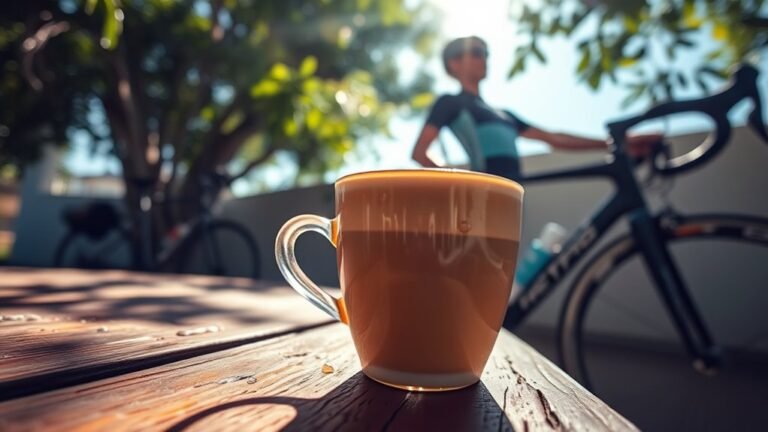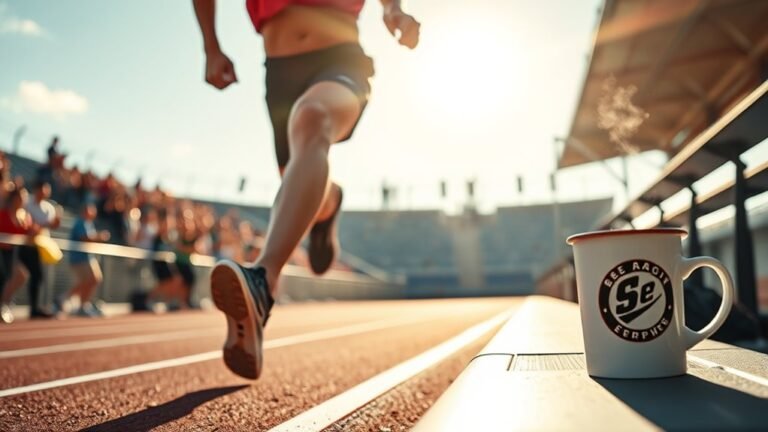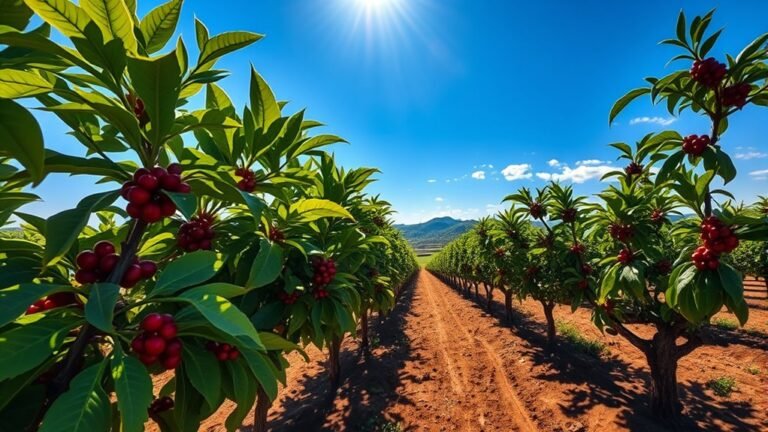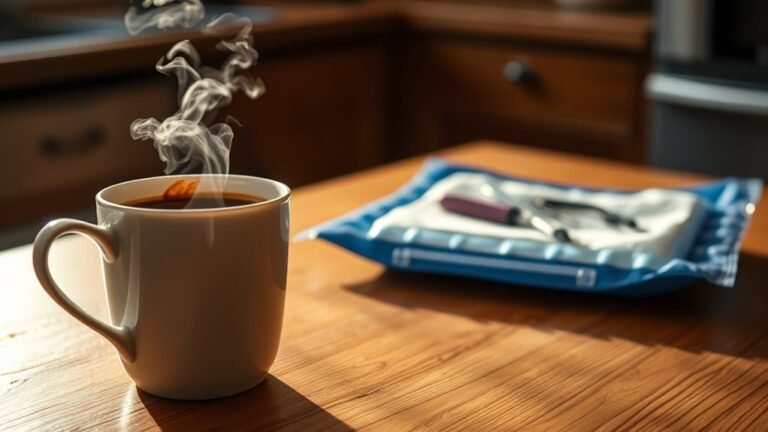Can I Make Espresso With Regular Coffee
You can’t technically make espresso with regular coffee, but you can brew a strong cup that mimics its rich flavor and intensity. Use a fine grind for the best extraction and consider methods like AeroPress or a Moka pot, which create coffee with espresso-like qualities. Focus on the right coffee-to-water ratios and experiment with different beans to enhance the taste. There’s more to explore about brewing techniques and flavor variations that can elevate your coffee experience.
Understanding Espresso and Regular Coffee
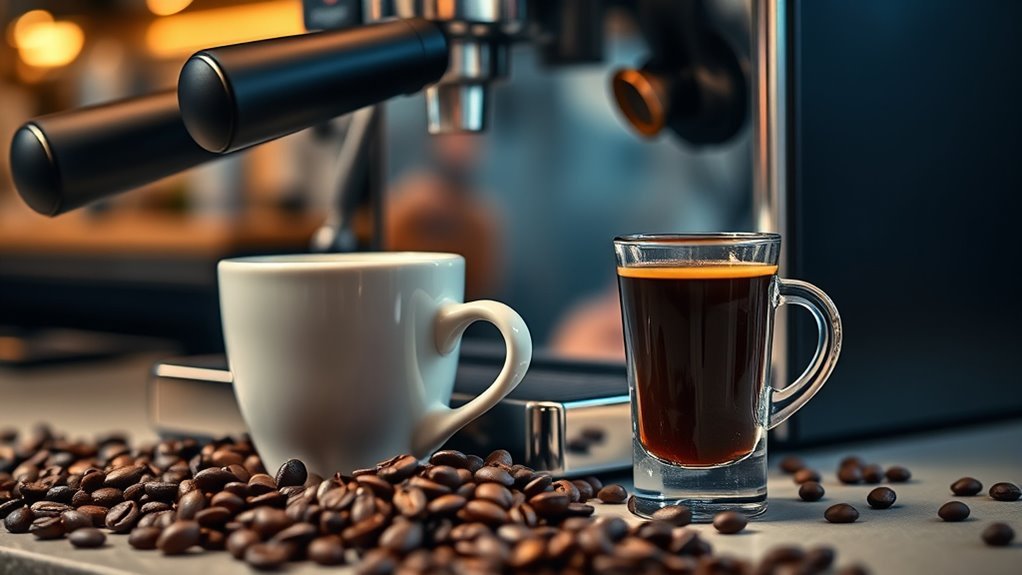
Espresso and regular coffee, while both beloved brews, differ markedly in their preparation and flavor profiles. Understanding their coffee origins is essential for appreciating these distinct beverages. Espresso originated in Italy in the early 20th century, evolving from a desire for a quick, concentrated coffee experience. Its brewing history involves forcing hot water through finely-ground coffee under pressure, resulting in a rich, bold flavor and a creamy crema on top. On the other hand, regular coffee has a broader history, with various brewing methods emerging globally, such as drip and French press. Each method highlights unique flavors and aromas, showcasing the versatility of coffee. By knowing these differences, you can better appreciate the nuances in your daily cup.
Key Differences Between Espresso and Regular Coffee
While both espresso and regular coffee are made from the same coffee beans, their brewing methods and characteristics set them apart considerably. Espresso is brewed with high pressure, extracting flavors quickly, resulting in a concentrated drink with remarkable espresso intensity. In contrast, regular coffee typically involves a slower brewing process, allowing for a gentler extraction of flavors. This difference in brewing affects not just taste but also texture: espresso has a rich, creamy consistency topped with crema, while regular coffee tends to be lighter and more diluted. Additionally, espresso’s higher caffeine concentration per ounce contrasts with the milder caffeine levels found in regular coffee, offering a different experience for those seeking a bold and robust flavor profile.
The Importance of Coffee Grind Size
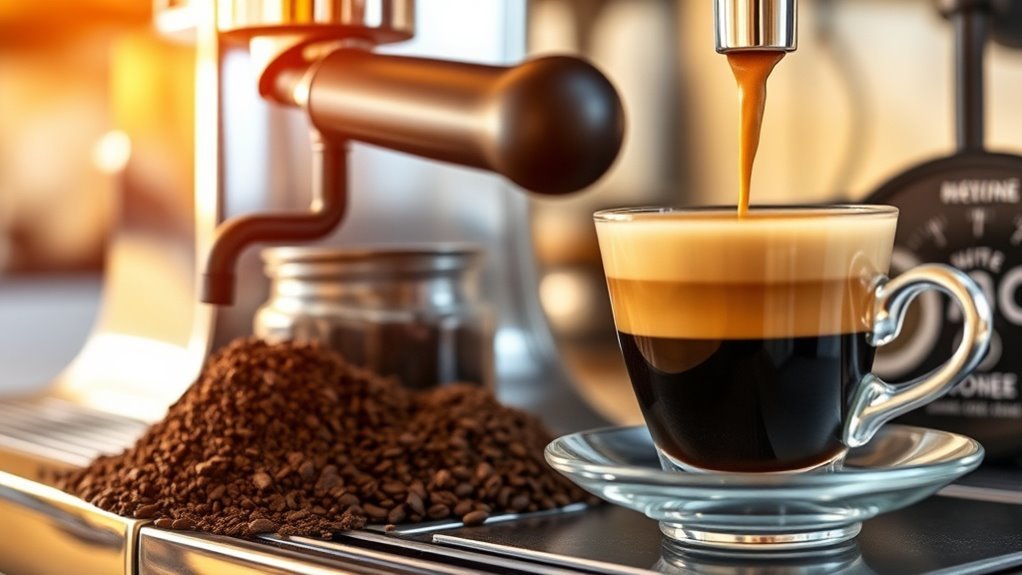
Grind size is essential for achieving the desired flavor and strength in your coffee, especially when trying to make espresso. Different brewing methods require specific grind sizes to optimize extraction and guarantee compatibility. If you use the wrong grind size, you might end up with an unbalanced cup that doesn’t highlight the coffee’s best characteristics.
Grind Size Matters
Coffee’s grind size greatly impacts the extraction process, determining the flavor and strength of your brew. When you’re aiming for espresso, achieving the right grind consistency is essential. Typically, a fine grind is preferred, as it maximizes surface area, allowing for ideal extraction under pressure. Different grind types, such as coarse or medium, won’t yield the same results. If your grind’s too coarse, you might end up with a weak, under-extracted shot, while a grind that’s too fine can lead to over-extraction, resulting in bitterness. Consistency in grind size also matters; uneven particles can cause inconsistent extraction, affecting the overall taste. So, for the best espresso experience, pay close attention to your coffee grind size.
Brew Method Compatibility
Understanding the compatibility of your brew method with the grind size is essential for achieving the desired flavor profile in your espresso. Different brewing techniques require specific grind sizes to optimize extraction. For instance, espresso demands a fine grind to create the pressure needed for a rich shot, while a coarser grind suits methods like French press. Your coffee equipment plays a significant role too; using a drip machine with espresso grind can lead to over-extraction and bitterness. Conversely, using a coarse grind in an espresso machine won’t yield the concentrated flavor you’re after. By aligning your grind size with your brewing style, you can reveal the full potential of your coffee, ensuring a satisfying experience with every cup.
Flavor Extraction Impact
While the grind size of your coffee may seem like a minor detail, it plays an essential role in flavor extraction during brewing. Proper grind size affects how water interacts with coffee grounds, influencing the extraction techniques you use. A finer grind typically enhances flavor profiles by increasing surface area, allowing for quicker extraction. This is vital for espresso, where pressure forces water through tightly packed grounds, creating a rich, concentrated shot. Conversely, a coarser grind may lead to under-extraction, resulting in a weak, sour taste. Understanding the relationship between grind size and flavor extraction empowers you to experiment freely, maximizing the potential of your coffee, whether you’re aiming for espresso or another brew method.
Brewing Methods to Mimic Espresso
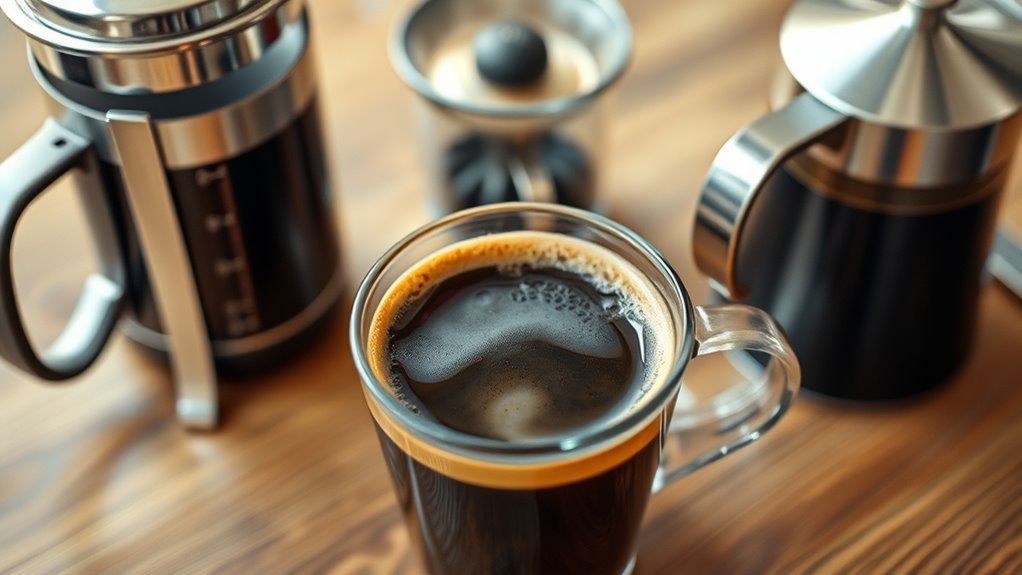
If you’re looking to replicate espresso without an espresso machine, several brewing methods can help achieve that rich flavor and concentrated body. Techniques like the French press, AeroPress, and stovetop Moka pot offer unique ways to mimic the espresso experience, each with its own set of advantages. Understanding these methods will enable you to create a satisfying cup that captures some essence of traditional espresso.
French Press Technique
Although a French press isn’t designed for espresso, you can use it to create a concentrated coffee that mimics some of the characteristics of espresso. Start by using a finer grind than usual, as this increases coffee strength. Aim for a coffee-to-water ratio of about 1:10, which allows for a richer flavor extraction. Boil water and let it cool slightly before pouring it over the grounds. Steep for about four minutes, then press the plunger slowly to avoid bitterness. This method won’t produce the same crema as traditional espresso, but it will yield a bold, full-bodied drink. Remember, while it won’t replicate espresso perfectly, your French press can still deliver a satisfying coffee alternative.
AeroPress Espresso Style
Using an AeroPress can be an excellent way to create a coffee that closely resembles espresso, especially when you need a quick and versatile brewing method. By applying specific AeroPress techniques, you can craft a concentrated brew that mimics the richness of traditional espresso.
- Use a fine grind for maximum extraction.
- Experiment with water temperature, aiming for around 200°F.
- Apply even pressure when pressing to guarantee uniform extraction.
These espresso alternatives provide a satisfying experience without the need for an espresso machine. The AeroPress’s adaptability allows you to fine-tune your brewing process, offering freedom to create a personalized cup that meets your taste preferences. Embrace the versatility of the AeroPress and enjoy your espresso-like creations!
Stovetop Moka Pot
While many coffee enthusiasts seek the rich, bold flavors of espresso, the stovetop Moka pot offers a practical alternative that can deliver similar intensity. Using this stovetop technique, you can enjoy moka pot benefits like affordability, ease of use, and portability.
Here’s a quick comparison to evaluate:
| Feature | Moka Pot | Espresso Machine |
|---|---|---|
| Cost | Low | High |
| Brewing Time | 5-10 minutes | 25-30 seconds |
| Maintenance | Easy to clean | Requires regular upkeep |
Using Aeropress for Strong Coffee
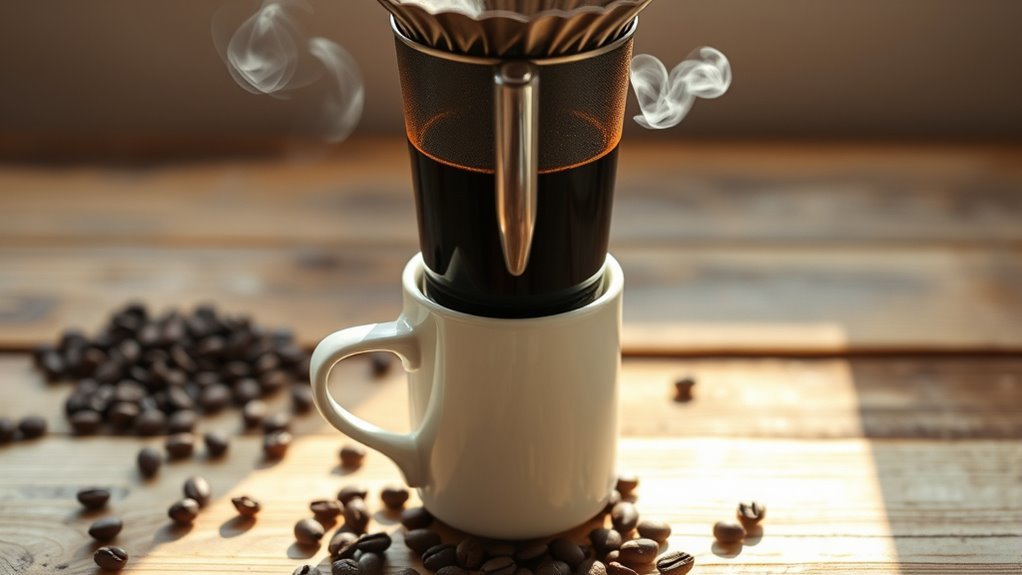
Brewing strong coffee with an Aeropress can elevate your morning ritual, offering a concentrated flavor similar to espresso. By mastering a few aeropress techniques, you can achieve impressive coffee strength without the need for expensive equipment.
Elevate your mornings with Aeropress; enjoy espresso-like strength and rich flavor without breaking the bank.
- Experiment with grind size: A finer grind enhances extraction.
- Adjust brew time: Longer steeping can intensify flavors.
- Use coffee-to-water ratio: A 1:15 ratio can yield a robust cup.
With these methods, you can customize your brew to your taste preferences. The Aeropress allows for versatility, enabling you to enjoy a strong, flavorful cup that mirrors traditional espresso. By embracing this approach, you gain the freedom to explore different coffee profiles while still enjoying the convenience of a compact brewing method.
Tips for Maximizing Flavor in Regular Coffee
To maximize flavor in regular coffee, it’s essential to focus on several key factors that influence the brewing process. Understanding coffee blends and their unique flavor profiles can elevate your cup considerably. Here are some tips to take into account:
| Factor | Tips |
|---|---|
| Grind Size | Use a medium grind for balance |
| Water Temperature | Aim for 195°F to 205°F |
| Brew Time | Stick to 4-5 minutes |
| Coffee-to-Water Ratio | Experiment with 1:15 to 1:18 |
| Freshness | Use freshly ground coffee |
The Role of Coffee Beans in Espresso

The choice of coffee beans plays a crucial role in determining the quality and flavor profile of espresso. Using the right espresso beans can elevate your drink, while the wrong choice can lead to disappointing results. Understanding the nuances of different coffee varieties helps you make informed decisions.
- Arabica vs. Robusta: Arabica offers sweetness and complexity, while Robusta provides a bold, bitter kick.
- Roast Levels: Darker roasts deliver intense flavors, while medium roasts can bring out nuanced tasting notes.
- Freshness: Freshly roasted beans yield better crema and richer flavors than stale beans.
Experimenting With Coffee Ratios and Additives
While many enthusiasts believe that using specific espresso beans is essential, experimenting with coffee ratios and additives can greatly impact the final result. By adjusting the coffee-to-water ratio, you can influence flavor intensity, body, and extraction time. Additive experimentation, like trying different sweeteners or spices, can enhance your brew’s complexity.
| Coffee Ratio | Additive | Flavor Profile |
|---|---|---|
| 1:2 | Sugar | Balanced sweetness |
| 1:3 | Cinnamon | Warm, spiced notes |
| 1:1 | Cocoa powder | Rich, chocolatey flavor |
| 1:4 | Vanilla extract | Creamy, aromatic taste |
| 1:2 | Nutmeg | Earthy, warming notes |
Don’t hesitate to explore these variations—your ideal espresso awaits!
Frequently Asked Questions
Can I Use Flavored Coffee Beans for Espresso?
“Variety is the spice of life,” and using flavored coffee beans for espresso can certainly add a unique twist to your brew. While traditional espresso relies on specific bean profiles, you can experiment with flavored options if you’re open to alternatives. Just remember, the key is to adjust your grind size and extraction time to get the best flavor. Enjoy the freedom to explore, but be mindful of the balance in your cup!
What Coffee Types Are Best for Espresso-Like Taste?
For an espresso-like taste, you’ll want to focus on coffee roast and brewing method. A medium to dark roast brings out the rich, bold flavors ideal for espresso. Opt for beans labeled as espresso or those with tasting notes of chocolate or caramel. The brewing method also matters; using a high-pressure system like an espresso machine extracts more oils and flavors, mimicking that signature espresso profile you’re after. Enjoy the freedom of experimentation!
How Does Water Temperature Affect Coffee Extraction?
Think of water temperature as the conductor of an orchestra, guiding the harmony of flavors in your coffee. It directly influences extraction time; too hot, and you risk bitterness, too cool, and you miss out on essential oils. Different brewing methods require specific temperatures to achieve ideal results, allowing you the freedom to explore diverse profiles. Mastering this balance reveals a world of rich, nuanced flavors in every cup you brew.
Can I Mix Espresso With Regular Coffee Drinks?
You can definitely mix espresso with regular coffee drinks to create unique coffee cocktails. Espresso blends can enhance the flavor profile of your regular coffee, adding depth and richness. By experimenting with different ratios, you’ll discover how the boldness of espresso complements the smoother notes of regular coffee. Just remember to balance the flavors, ensuring neither overpowers the other, allowing you to enjoy a liberating coffee experience tailored to your taste.
What Is the Ideal Coffee-To-Water Ratio for Strong Coffee?
When brewing coffee, think of it as crafting a symphony of flavors. For strong coffee, aim for a coffee-to-water ratio of about 1:15 to 1:17. This means for every gram of coffee, use 15 to 17 grams of water. Adjusting this ratio can heighten strength levels, creating a bold cup that sings. Experiment with these ratios during your coffee brewing sessions to discover your perfect harmony of taste and intensity.

